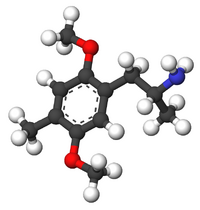Assessment |
Biopsychology |
Comparative |
Cognitive |
Developmental |
Language |
Individual differences |
Personality |
Philosophy |
Social |
Methods |
Statistics |
Clinical |
Educational |
Industrial |
Professional items |
World psychology |
Biological: Behavioural genetics · Evolutionary psychology · Neuroanatomy · Neurochemistry · Neuroendocrinology · Neuroscience · Psychoneuroimmunology · Physiological Psychology · Psychopharmacology (Index, Outline)
| DOM | |
|---|---|
| Chemical name | (2,5-Dimethoxy-4-methylamphetamine or 1-(2,5-dimethoxy-4-methylphenyl)-2-aminopropane |
| Chemical formula | C12H19NO2 |
| Molecular mass | 209.29 g/mol |
| Melting point | 61 °C |
| CAS numbers | 315588-95-1, 26011-50-7, 43061-13-8, 43061-14-9 |
| SMILES | N[C@H](C)CC1=C(OC)C=C(C)C(OC)=C1 (R-isomer) |
 
| |
DOM (or STP, allegedly standing for Serenity, Tranquillity and Peace, but based on the name of a motor oil called STP and thus named by Owsley Stanley) is a psychedelic hallucinogenic drug and a substituted amphetamine of the phenethylamine class of compounds, sometimes used as an entheogen. DOM was first synthesized by Alexander Shulgin. The full name of the chemical is 4-methyl-2,5-dimethoxyamphetamine. DOM has a stereocenter and R-(-)-DOM is the more active stereoisomer. In his book PIHKAL (Phenethylamines I Have Known and Loved), Shulgin lists the dosage range as 3 to 10 mg. DOM is generally taken orally. DOM is classified as a Schedule 1 substance in the United States, and is similarly controlled in other parts of the world. Internationally, DOM is a Schedule I drug under the Convention on Psychotropic Substances[1].
Not much information is known about the toxicity of DOM. According to Shulgin, the effects of DOM typically last 14 to 20 hours. Clinical studies have indicated that repeated exposures to DOM can result in the rapid development of tolerance in as little as three days.
In mid-1967, tablets containing 20mg (later 10mg) of DOM were widely distributed in the Haight-Ashbury District of San Francisco under the name of STP. This short-lived appearance of DOM on the black market proved disastrous for several reasons. First, the tablets contained an excessively high dose of the chemical. This, combined with DOM’s slow onset of action (which encouraged some users, familiar with drugs that have quicker onsets, such as LSD, to re-dose) and its remarkably long duration, caused many users to panic and sent some to the emergency room. Second, treatment of such overdoses was complicated by the fact that no one at the time knew that the tablets called STP were, in fact, DOM.
Another structural isomer of DOM is also known to be active. This compound has the methoxy groups at the 2,6 positions instead, and is known as Ψ-DOM.
References[]
- ↑ List of psychotropic substances under international control. URL accessed on 2007-03-30.
See also[]
External links[]
Categorization[]
Psychedelic phenethylamines
| |
|---|---|
Aleph • 2C-B • 2C-B-FLY • 2C-C • 2C-D • 2C-E • 2C-F • 2C-G • 2C-I • 2C-N • 2C-O • 2C-O-4 • 2C-P • 2C-T • 2C-T-2 • 2C-T-4 • 2C-T-7 • 2C-T-8 • 2C-T-9 • 2C-T-13 • 2C-T-15 • 2C-T-17 • 2C-T-21 • 2C-TFM • 3C-E • 3C-P • Br-DFLY • DESOXY • DMMDA-2 • DOB • DOC • DOET • DOI • DOM • DON • Escaline • Ganesha • HOT-2 • HOT-7 • HOT-17 • Isoproscaline • Lophophine • MDA • MMDA • MMDA-2 • MMDA-3a • MMDMA • Macromerine • Mescaline • Proscaline • TMA |
.
| This page uses Creative Commons Licensed content from Wikipedia (view authors). |